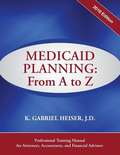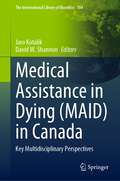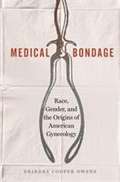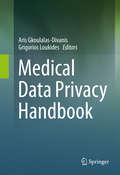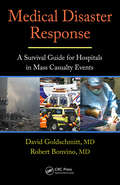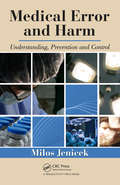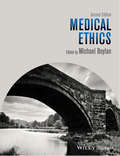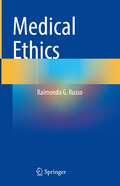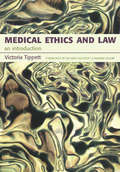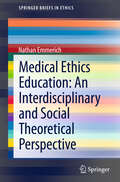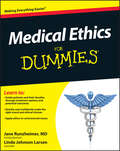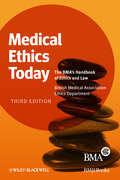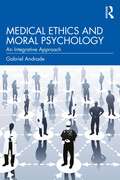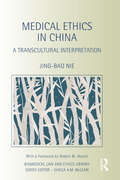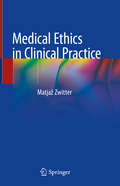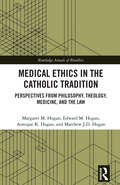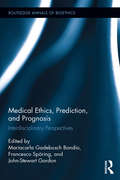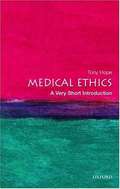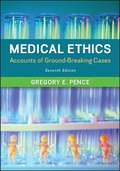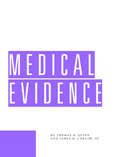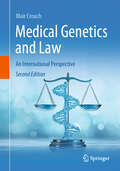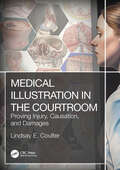- Table View
- List View
Medicaid Planning: From A to Z (2018 Ed. )
by K. Gabriel HeiserIf you wish to advise clients how to qualify for nursing home Medicaid while protecting their assets, this is the definitive book! Written by an elder law attorney with over 25 years of experience, this manual is the professional edition version of attorney Heiser's best-selling Medicaid Secrets book. This manual is geared toward attorneys, accountants, and financial advisors seeking up-to-date and accessible information on the Medicaid program rules as well as a complete analysis of available Medicaid asset protection techniques for their clients. Includes a summary of all income and asset rules for both married and single individuals, together with numerous examples and several case studies, which take the planner through the same thought processes that an experienced elder law attorney would go through when analyzing a real-life client's situation. The book includes tips on: how to title the home so the client does not lose it to the state; how to make transfers to family members that won't disqualify the client from Medicaid; how "Medicaid annuities" work to make assets "disappear" for Medicaid eligibility purposes; clever ideas for "spending down" assets; what to change in a client's will to save thousands of dollars if the spouse ever needs nursing home care; avoiding the state's reimbursement claim following the nursing home resident's death; and much more. The 2018 Edition has been expanded, revised, and completely updated to incorporate all changes in the law as of January 1, 2018, and includes two chapters on Veterans' benefits as well as a 39-page Ethics of Elder Law section. Completely annotated with all case citations and statutory references given in over 560 footnotes. Also includes full copies of relevant statutes and a sample filled-out Medicaid application, plus sample clauses for deeds, wills, powers of attorney, etc.
Medical Accident Liability and Redress in English and French Law
by Simon TaylorIn 2002 France introduced an out-of-court settlement scheme for medical accidents. The scheme guarantees compensation for the victims of the most serious medical accidents irrespective of fault and operates in parallel with existing liability rules. In this book Simon Taylor compares English and French law on medical accident liability and redress and considers what lessons the French model can provide for potential reform in England and elsewhere. Taylor emphasizes the effect of the English and French rules on access to compensation and on the cost of liability and examines the problems that have been posed by the introduction of an administrative redress scheme in France. This book looks at the potential consequences of English and French rules for the doctor-patient relationship and for patient safety, and considers the role that national legal traditions and cultures of civil liability in England and France play in shaping national law in this area.
Medical Assistance in Dying: Key Multidisciplinary Perspectives (The International Library of Bioethics #104)
by Jaro Kotalik David W. ShannonThis book, written both for a Canadian and an international readership, provides a multidisciplinary review of the framework and performance of the Canadian Medical Assistance in Dying (MAID) program. In the first five years (2015-2021) of operation, this program delivered voluntary euthanasia and assistance in suicide to over 30,000 Canadian residents, presently representing a 30% annual growth. Looking back on these first five years, the 30 Canadian scholars and clinicians contributing to this volume raise important issues and attempt to answer key questions that have arisen in regards to its operation and its stated objectives. This volume strikes the most appropriate balance between the autonomy of persons who seek medical assistance, versus the interests and protection of vulnerable persons. Finally, the book makes suggestions on how the program can presently be improved. It identifies gaps in knowledge about MAID’s operational program and its impact on individuals, families and society in order to stimulate the necessary research that is essential to the evolution of a healthy and well-balanced program. As a first, comprehensive examination of medically assisted deaths in Canada, this publication will be of great value to lay, professional, academic, political audiences both domestically and internationally, especially in jurisdictions that are examining their options of permitting assisted deaths.
Medical Bondage: Race, Gender, And The Origins Of American Gynecology
by Deirdre Cooper OwensThe accomplishments of pioneering doctors such as John Peter Mettauer, James Marion Sims, and Nathan Bozeman are well documented. It is also no secret that these nineteenth-century gynecologists performed experimental caesarean sections, ovariotomies, and obstetric fistula repairs primarily on poor and powerless women. Medical Bondage breaks new ground by exploring how and why physicians denied these women their full humanity yet valued them as ?medical superbodies? highly suited for medical experimentation. In Medical Bondage, Cooper Owens examines a wide range of scientific literature and less formal communications in which gynecologists created and disseminated medical fictions about their patients, such as their belief that black enslaved women could withstand pain better than white ?ladies.' Even as they were advancing medicine, these doctors were legitimizing, for decades to come, groundless theories related to whiteness and blackness, men and women, and the inferiority of other races or nationalities. Medical Bondage moves between southern plantations and northern urban centers to reveal how nineteenth-century American ideas about race, health, and status influenced doctor-patient relationships in sites of healing like slave cabins, medical colleges, and hospitals. It also retells the story of black enslaved women and of Irish immigrant women from the perspective of these exploited groups and thus restores for us a picture of their lives.
Medical Data Privacy Handbook
by Aris Gkoulalas-Divanis Grigorios LoukidesThis handbook covers Electronic Medical Record (EMR) systems, which enable the storage, management, and sharing of massive amounts of demographic, diagnosis, medication, and genomic information. It presents privacy-preserving methods for medical data, ranging from laboratory test results to doctors' comments. The reuse of EMR data can greatly benefit medical science and practice, but must be performed in a privacy-preserving way according to data sharing policies and regulations. Written by world-renowned leaders in this field, each chapter offers a survey of a research direction or a solution to problems in established and emerging research areas. The authors explore scenarios and techniques for facilitating the anonymization of different types of medical data, as well as various data mining tasks. Other chapters present methods for emerging data privacy applications and medical text de-identification, including detailed surveys of deployed systems. A part of the book is devoted to legislative and policy issues, reporting on the US and EU privacy legislation and the cost of privacy breaches in the healthcare domain. This reference is intended for professionals, researchers and advanced-level students interested in safeguarding medical data.
Medical Disaster Response: A Survival Guide for Hospitals in Mass Casualty Events
by David Goldschmitt Robert BonvinoWhile the job of a clinician in a disaster scenario is to save lives without regard for the cause or rationale for the injury, medical and emergency professionals who understand the diverse aspects of a disaster are better equipped to respond effectively. Giving emergency personnel the tools they need to perform in catastrophic situations, Medical
Medical Error and Harm: Understanding, Prevention, and Control
by Milos JenicekRecent debate over healthcare and its spiraling costs has brought medical error into the spotlight as an indicator of everything that is ineffective, inhumane, and wasteful about modern medicine. But while the tendency is to blame it all on human error, it is a much more complex problem that involves overburdened systems, constantly changing techno
Medical Ethics
by Michael BoylanThe second edition of Medical Ethics deals accessibly with a broad range of significant issues in bioethics, and presents the reader with the latest developments. This new edition has been greatly revised and updated, with half of the sections written specifically for this new volume.An accessible introduction for beginners, offering a combination of important established essays and new essays commissioned especially for this volumeGreatly revised - half of the selections are new to this edition, including two essays on genetic enhancement and a section on gender, race and cultureIncludes new material on ethical theory as a grounding for understanding the ethical dimensions of medicine and healthcareNow includes a short story on organ allocation, providing a vivid approach to the issue for readersProvides students with the tools to write their own case study essaysAn original section on health provides a theoretical context for the succeeding essaysPresents a carefully selected set of readings designed to progressively move the reader to competency in subject comprehension and essay writing
Medical Ethics
by Raimondo G. RussoMedical practitioners have always been expected to abide by certain standards of conduct and uphold certain values, more or less throughout the world. In this book, besides discussing specific ethical issues, the author ponders questions such as the right to life and the integrity of the human person. Ethics in medicine takes account of the principles that underlie the best decisions, particularly in unusual circumstances – such as a pandemic. Many of these are enshrouded in the oaths most doctors take – the Hippocratic Oath is perhaps the best known, and has influenced numerous others over the centuries. However, these principles and the resulting conduct have taken different directions at various moments in history and in different parts of the globe, though always primarily oriented to the protection of human health. The author compares some interesting similarities and differences, tracing the main social, legal and religious attitudes, in what has come to be known as"medical ethics", with all its benefits to Mankind. Alongside basic human dignity, four main values have been pivotal in medical ethics: Caring for sick people, putting their well-being at the center of concern, and doing good. Not causing harm: never making a patient take risks, and never prescribing a doubtful treatment. Fairness: treating all patients in accordance with their health needs, never favoring or neglecting anyone on the basis of background, occupation, etc. Self-determination: the patient can be informed about treatments and, when possible, should approve the prescriptions. The doctor must show empathy, respect for confidentiality, and responsibility. Briefly, this overview of the medical profession’s ethics focuses on experience, principles, aims, virtues and above all the basic rules which in various places through the centuries have governed the tortuous paths of Mankind. Written byan acclaimed expert in the field, this book is of value for all those working in healthcare, and people interested in its ethics.
Medical Ethics And Law: An Introduction
by Victoria TippettThis book is to help you understand the main ethical and legal details you need to know in order to practice medicine safely and well. Medical ethics is an inherently fascinating subject, and throws up new issues every day. Good ethical thinking requires practice and application and there are essentials that are easy to grasp and learn quickly - this book will show you how. It contains short summaries, with examples, and guidance on your legal position, of a series of core topics of medical ethics and law. Its aim is to give you some guides to effective, safe and good clinical practice.
Medical Ethics Education: An Interdisciplinary and Social Theoretical Perspective
by Nathan EmmerichThere is a diversity of 'ethical practices' within medicine as an institutionalised profession as well as a need for ethical specialists both in practice as well as in institutionalised roles. This Brief offers a social perspective on medical ethics education. It discusses a range of concepts relevant to educational theory and thus provides a basic illumination of the subject. Recent research in the sociology of medical education and the social theory of Pierre Bourdieu are covered. In the end, the themes of Bourdieuan Social Theory, socio-cultural apprenticeships and the 'characterological turn' in medical education are draw together the context of medical ethics education.
Medical Ethics For Dummies
by Linda Johnson Larsen Jane RunzheimerA practical, insightful guide to the moral and ethical standards of healthcareSucceeding in the healthcare field means more than just making a diagnosis and writing a prescription. Healthcare professionals are responsible for convincing patients and their family members of the best course of action and treatments to follow, while knowing how to make the right moral and ethical choices, and so much more. Unlike daunting and expensive texts, Medical Ethics For Dummies offers an accessible and affordable course supplement for anyone studying medical or biomedical ethics.* Follows typical medical and biomedical ethics courses* Covers real ethical dilemmas doctors, nurses and other healthcare workers may face* Includes moral issues surrounding stem cell research, genetic engineering, euthanasia, and morePacked with helpful information, Medical Ethics For Dummies arms aspiring medical professionals with the philosophical and practical foundation for advancing in a field where critical ethical and moral decisions need to be rapidly and convincingly made.
Medical Ethics Today
by British Medical AssociationThis is your source for authoritative and comprehensive guidance from the British Medical Association (BMA) Medical Ethics Department covering both routine and highly contentious medico-legal issues faced by health care professionals. The new edition updates the information from both the legal and ethical perspectives and reflects developments surrounding The Mental Capacity Act, Human Tissue Act, and revision of the Human Fertilisation and Embryology Act.
Medical Ethics and Moral Psychology: An Integrative Approach
by Gabriel AndradeMedical Ethics and Moral Psychology: An Integrative Approach is a pioneering book which provides a comprehensive exploration of the ethical challenges in contemporary healthcare. Seamlessly combining insights from medical ethics and moral psychology, this interdisciplinary work illuminates critical issues that have become particularly relevant in recent times, especially in the context of culture wars.This integrative approach enables readers to gain a deeper understanding of how moral decision-making is influenced by cognitive biases, societal attitudes, and philosophical frameworks. The book meticulously examines the complexities of vaccine mandates, addressing psychological resistance and conspiracy theories, while discussing self-defense arguments in abortion debates and the cognitive dissonance surrounding fetal personhood. It further provides a balanced analysis of euthanasia by navigating the nuanced distinctions between killing and letting die, and it interrogates the ethical implications of Assisted Reproductive Technologies amidst the clash of technological advancement and traditional values.By highlighting issues of justice in healthcare resource distribution, including systemic racism and equity, this work also equips readers with the tools necessary to engage thoughtfully with contemporary ethical dilemmas and the moral psychology aspects that contextualize them, fostering informed decision-making and the development of just healthcare policies with greater sensitivity and depth.Drawing on insights from psychology, sociology, anthropology and history to offer a comprehensive understanding of the complex dynamics shaping medical ethical decision-making, this is ideal reading for students and researchers in moral psychology, medical ethics, philosophy and public health. It is also designed for healthcare professionals, ethicists and policymakers.
Medical Ethics and the Elderly: practical guide
by Gurcharan S RaiThis concise, introductory handbook discusses the basic principles of medical ethics, and includes practical, realistic guidance on how to evaluate and manage common ethical problems, focusing on the care of elderly patients Typical scenarios faced in clinical practice, such as issues of mental capacity and consent, resuscitation, near death decisions, quality of life, and health care expenditure, are discussed
Medical Ethics in China: A Transcultural Interpretation (Biomedical Law and Ethics Library)
by Jing-Bao NieDrawing on a wide range of primary historical and sociological sources and employing sharp philosophical analysis, this book investigates medical ethics from a Chinese-Western comparative perspective. In doing so, it offers a fascinating exploration of both cultural differences and commonalities exhibited by China and the West in medicine and medical ethics. The book carefully examines a number of key bioethical issues in the Chinese socio-cultural context including: attitudes toward foetuses; disclosure of information by medical professionals; informed consent; professional medical ethics; health promotion; feminist bioethics; and human rights. It not only provides insights into Chinese perspectives, but also sheds light on the appropriate methods for comparative cultural and ethical studies. Through his pioneering study, Jing-Bao Nie has put forward a theory of "trans-cultural bioethics," an ethical paradigm which upholds the primacy of morality whilst resisting cultural stereotypes, and appreciating the internal plurality, richness, dynamism and openness of medical ethics in any culture. Medical Ethics in China will be of particular interest to students and academics in the fields of Medical Law, Bioethics, Medical Ethics, Cross-Cultural Ethics as well as Chinese/Asian Studies and Comparative Cross-Cultural Studies.
Medical Ethics in Clinical Practice
by Matjaž ZwitterThis book discusses medicine from an ethical perspective, whereas books on medical ethics more commonly present ethics from a bio-medical standpoint. The book is divided into 23 chapters. The introductory chapters present some basic concepts of medical ethics, such as the relation between the legal system and ethics, ethical documents, ethical theories, and ethical analysis. The following chapters address issues of importance in all fields of medicine: respecting autonomy, communication, relations within a healthcare team, professional malpractice, limited resources, and the portrait of a physician. In turn, the third part of the book focuses on ethical aspects in a broad range of medical activities – preventive medicine, human reproduction, genetics, pediatrics, intensive care, palliative medicine, clinical research, unproven methods in diagnostics and treatment, and the role of physicians who aren’t directly responsible for patient care. The last part presents students’ seminars with case stories. The book offers a valuable resource for physicians of all specialties, students of medicine, professionals, and students from other fields devoted to human health, journalists, and general readers with an interest in medicine.
Medical Ethics in the Catholic Tradition: Perspectives from Philosophy, Theology, Medicine, and the Law (Routledge Annals of Bioethics)
by Margaret M. Hogan Edward M. Hogan Annique K. Hogan Matthew J.D. HoganThis book is a comprehensive survey and a sustained treatment of the major topics in contemporary medical ethics from within the Roman Catholic tradition. It brings together perspectives from philosophy, theology, medicine, and law to explore the traditions that undergird Catholic medical ethics.The authors of this book are, respectively, a philosopher, theologian, physician, and attorney. Their commitment to the Roman Catholic tradition provides the foundational principles for addressing a wide range of issues in contemporary medical ethics. These topics include abortion, reproduction, cloning to produce children, cloning for biomedical research, embryonic stem cell use, genetics as screening, testing, therapy, enhancement, engineering, specific special relations such as maternal/fetal, physician/patient, mentally ill/caretakers, health care, and end of life issues. Furthermore, the book elaborates on the ways in which the authors’ professions and disciplines act in service to medicine as an instrument for real human flourishing.Medical Ethics in the Catholic Tradition is for the physician who would like to know more about the philosophical/theological/legal traditions that undergird the Catholic position. It is for the attorney who would like to know more about the philosophical/theological/medical traditions that undergird the Catholic position. Similarly, the philosopher or theologian can find here the appropriate information to understand how science and law contribute to the development of the Catholic position on major issues in medical ethics.
Medical Ethics, Prediction, and Prognosis: Interdisciplinary Perspectives (Routledge Annals of Bioethics)
by John-Stewart Gordon Mariacarla Gadebusch Bondio Francesco SporingRecent scientific developments, in particular advances in pharmacogenetics and molecular genetics, have given rise to numerous predictive procedures for detecting predispositions to diseases in patients. This knowledge, however, does not necessarily promise benign results for either patients or health care professionals. The aim of this volume is to analyse issues related to prediction and prognosis as a burgeoning field of medicine, which is revolutionizing the way we understand and approach diagnosis and treatment. Combining epistemic and ethical reflection with medical expertise on contemporary practice and research, an interdisciplinary group of international experts critically examine anticipatory medicine from various perspectives, including history of medicine, bioethics, theories of science, and health economics. The highly complex issues involved in medical prediction call for a far-reaching debate on the value and scope of foreknowledge. For example, which responsibilities and burdens arise when still healthy people learn of their predisposition to diseases? How should health care insurance reflect risky life styles? Is the increasing medicalization of life connected with prevention ethically sustainable and financially possible in the developing world? These and other related issues are the subject of this timely and important book, which not only serves as an introduction to the area, but also proposes many feasible solutions to the problems outlined.
Medical Ethics: A Very Short Introduction
by Tony HopeMedical ethics is an area that has particular interest for the general public as well as for the medical practitioner, and issues concerning medical ethics seem to be constantly in the headlines. This short and accessible introduction provides an invaluable tool with which to think about the ethical values that lie at the heart of medicine. Tony Hope deals with thorny moral issues, including euthanasia and the morality of killing. He also explores political questions, such as how we can make sure health care resources are distributed fairly. Each chapter in the book considers a different issue, for example, genetics, modern reproductive technologies, resource allocation, mental health, and medical research. Each section also discusses controversial questions such as: Who should have access to reproductive technology? Is it right to fund expensive drug treatment for individuals? Should treatment for mental illness be imposed on patients without their consent? Considering a wide range of questions of medical ethics, this Very Short Introduction will help to explain some of the confusing issues facing the field of medicine today.
Medical Ethics: Accounts of Groundbreaking Cases (Seventh Edition)
by Gregory E. PenceGregory Pence helped found the Bioethics field and has published in this area for forty years. In this text his single, authorial voice integrates descriptions of some of the most famous bioethics cases and their issues. The text is the only one that follows cases over decades to tell readers what did, and often, what did not, happen. This new edition retains in-depth discussion of famous cases, while providing updated, detailed analysis of newly raised issues.
Medical Evidence
by Thomas Quinn James LawlorMedical Evidence When litigating difficult-to explain medical issues, pictures are worth a lot more than a thousand words. Unfortunately, medically-accurate illustrations can cost hundreds of dollars each. Here is affordable help. Thomas Quinn and James Lawlor's Medical Evidence will equip you to handle medical topics with confidence and authority, providing: * Over 400 detailed medical illustrations * Anatomy in plain English * Case studies of common injuries * Questions and answers for experts * Sources of additional information These are not simple line drawings you usually find in law books. Medical Evidence contains professional-quality illustrations and photographs of extraordinary detail. All are labeled and supported by textual discussions.
Medical Genetics and Law: An International Perspective
by Mair CrouchThis book is an essential resource to understanding the intersection of medical genetics and law. In a unique approach, it provides an overview on the biological principles of DNA basics and genetic inheritance linking the knowledge with the ethical and legal challenges presented by modern developments in genetics. The first chapters educate the reader in key concepts such as cell division, genetic inheritance, genome study methods, genetic screening and testing across various countries. It further expands into complex issues where regulation is required, in particular: controversial aspects of genetic modifications, ethical concerns around patient confidentiality and biobanks' role in linking genetic variation to complex diseases. It includes legal cases regarding negligence claims from conception to adulthood and reflects on the impact of present and future developments in genomics on the law. Readers will gain a deeper understanding of how developments in genetics impact individuals and society, helping them navigate this rapidly evolving field. Given the interdisciplinary approach, the book is suitable for both medical and law students, practicing lawyers, medical practitioners, and genetic counselors. It is particularly beneficial for those who deal with medical negligence and need to understand the genetic aspects of such cases.
Medical Humanities
by Thomas R. Cole Nathan S. Carlin Ronald A. Carson Thomas R. Cole Nathan S. CarlinThis textbook brings the humanities to students in order to evoke the humanity of students. It helps to form individuals who take charge of their own minds, who are free from narrow and unreflective forms of thought, and who act compassionately in their public and professional worlds. Using concepts and methods of the humanities, the book addresses undergraduate and premed students, medical students, and students in other health professions, as well as physicians and other healthcare practitioners. It encourages them to consider the ethical and existential issues related to the experience of disease, care of the dying, health policy, religion and health, and medical technology. Case studies, images, questions for discussion, and role-playing exercises help readers to engage in the practical, interpretive, and analytical aspects of the material, developing skills for critical thinking as well as compassionate care.
Medical Illustration in the Courtroom: Proving Injury, Causation, and Damages
by Lindsay E. CoulterMedical Illustration in the Courtroom: Proving Injury, Causation, and Damages educates the reader on how to communicate science visually—in personal injury, medical malpractice, criminal, and forensic cases—by creating art that utilizes medical records, radiographs, and computer software. Medical illustration bridges the gap between complex technical, medical, and scientific concepts to clearly illustrate, and explain visually, a medical condition, negligence, or the causation of an injury or death to the lay person. Medical artists are frequently challenged with illustrating injuries and medical conditions that can’t be seen by the naked eye. And while using medical photography and imaging for illustrative purposes can be helpful, to an untrained eye it can often be unclear or confusing. This is where the medical illustrator enters the equation. There are often patients who have recovered from an injury or infection that appear in good health. However, should an unforeseen injury or fatality happen, medical illustrators can reveal to people what’s actually going on inside the person, an invaluable asset to attorneys in the courtroom—especially for personal injury and medical malpractice cases. While many attorneys utilize medical artists, nonvisual people don’t always recognize the value of demonstrative aids until they see them first-hand.When attorneys and their clients enlist the aid of medical artists, it quickly becomes apparent that properly conceived and executed artwork is invaluable to illustrating the facts—and medical impacts—of any number of scenarios: homicides by shooting, stabbings, vehicular accidents, in addition to medical malpractice and personal injuries resulting from surgery or possible negligence.Presenting a myriad of services and computer technologies that can be utilized, Medical Illustration in the Courtroom provides demonstrative aids used in cases to illustrate personal injury and medical malpractice, employing "tricks of the trade" to create an accurate effective image. Such images are educational to attorneys, insurance adjusters, judges, and juries to help create a visual storyline, the goal being to help combine art and science to provide a clear illustration of events to help in adjudicate legal and forensic cases.
